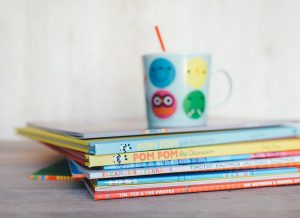
Let’s say hello to the babies / Let’s say hello to the babies / Hello, hello, hello, hello / Let’s say hello to the babies.
This simple song was one of the first that I heard when learning to do baby story times. It’s so often that the library is considered a “kids'” place or an “adult” space, but not too many people think of the library as a “baby” space. There’s a very simple explanation for this misconception: babies don’t read, so why would they use the library? Those of us in the know understand, however, that literacy doesn’t start with reading. The earliest literacy begins with helping babies understand sounds, associate words (an inherently abstract concept) with concrete items, all of which help build their communication skills and fundamental understanding of their world. It’s also helpful for babies to understand the idea of books. The more they’re exposed to them in their young life, the more they are likely to find enjoyment in them as they get older. Children are also expanding their vocabularies in their youngest years. The more words they are exposed to, even if they don’t know the meaning of them right away, the more likely they are for their vocabulary to build. In fact, most children who have been regularly exposed to books at a young age are more likely to be prepared for kindergarten.
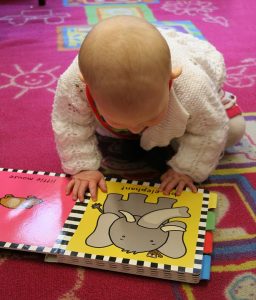
But baby story times aren’t just about the books. In fact, books are only a small part of what the story time is about because librarians know that kids at that young age aren’t ready to read just yet. There are plenty of other ways to build literacy and aid development. Singing is a big component of baby story time because singing slows down words to allow children to become more aware of individual sounds that create words (phonological & phonemic awareness). Singing also involves a lot of repetition which is how anyone, not just babies learn.
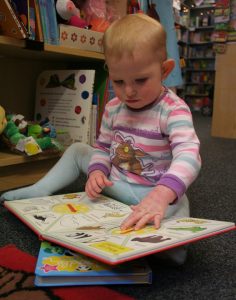
There is also a large amount of caregiver involvement with baby story times. Certainly even the best of librarians can’t manage a room full of infants and toddlers by themselves! Ideally, there is a 1-child-to-1-lap ratio which allows a caregiver to cuddle, tickle, rock, sway and otherwise get involved with their baby. This encourages trust between the child and caregiver and establishes a sense of security and bonding. It’s also a great opportunity for babies to increase their strength and coordination with a caregiver’s help. Bounces, tickles and swaying all help the child develop a sense of balance and helps them gain spatial awareness in a safe environment.
So why am I getting on my soap box this week to talk about why babies belong in the library as much as anyone else? Well, I’m excited to be offering a new Baby Story Time and a Toddler Story Time at the South Branch starting this coming Wednesday, September 21st!! Baby Story Time will be for infants ages 0-18 months at 10AM and Toddler Story Time will be for the wee ones ages 18-36 months at 11AM. We have some wonderful young families in Peabody that deserve to have their local library be a place where they can come and enjoy themselves. Each session will run for 4 weeks with a 1 week break in between. It’s an opportunity for infants to be exposed to the great offerings the library has and hopefully to create lifelong library patrons. As with all of our programs, it’s free and open to the public, but unlike many of our library programs, we’re not requiring registration. Babies can be unpredictable, and we want these programs to be as welcoming and accommodating as possible. My hope is that this creates an opportunity for a previously underserved population to come in and enjoy the library!
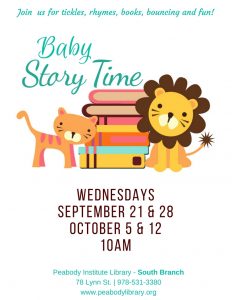
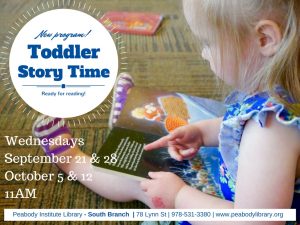
*A note on sources: the information about early literacy was accumulated through many resources. Because the books aren’t available in the NOBLE network I haven’t listed them here, but will be happy to share any titles and resources with anyone who is interested!
